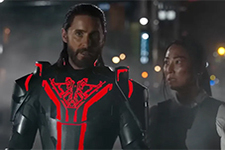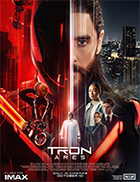Tron: Ares
|  Tron: Ares, the third entry in Disney’s now 43-year-old science fiction franchise, finally gets it right. Steve Lisberger’s original, which was a critical and commercial bomb back in the summer of 1982, was more of an experiment than a feature film—not just the first extended attempt to meld live action with computer animation, but the first mainstream stab at imagining the world inside computers, which at the time were just beginning to fully infiltrate our everyday lives. Three decades later, we got Joseph Kosinski’s Tron: Legacy (2010), which expanded on both the depth and scale of computer-generated imagery, as well as the philosophical conundrums of the original’s immersion of human consciousness into the digital realm. It was a better film in just about every way, but its plot was murky and its dense questions about human-computer interactions, the limits of space and time, and the future of the human condition were ultimately exhausting. The Daft Punk soundtrack was epic, as were the visuals, but it failed, like the original, to fully connect on a human level. Tron: Ares, on the other hand, finally manages that balance between spectacular visuals and an emotional core that keeps you engaged beyond the visual “wow factor” (it also throws in plenty of nostalgia for the older viewers who remember what “the Grid” looked like circa-1982, who immediately start tapping their feet whenever Depeche Mode’s “Just Can’t Get Enough” plays, and who feel fulfilled just seeing Jeff Bridges on-screen). Ironically, the protagonist of the first Tron movie to feel fully emotionally alive is not a human, but a computer program in human form. The trick this time, though, is that the computer program has been brought into the “real” world via a lot of elaborate technology involving lasers that can give physical form to anything that can be rendered digitally in a computer. While the first two films allowed humans to penetrate the mysteries of computers by fully inhabiting their space, Tron: Ares asks what would happen if entities created within computer space by humans were to inhabit the human world. At a time when there is so much deserved hand wringing over artificial intelligence and what it means for the future of humanity, the core concept of Tron: Ares is spectacularly of-the-moment. The title character, Ares (Jared Leto), is a Master Control Program created by Julian Dillinger, the grandson of Edward Dillinger, the villain of the first Tron. While both his father and grandfather worked for ENCOM, the computer company created by the series’ hero Kevin Flynn (Bridges), Julian has broken off and formed his own rival company and is set on landing massive military contracts by using computer technology to create military hardware, weapons, and soldiers. Ares, his ultimate creation, is presented to stakeholders and military brass as “the ultimate soldier”—“biblically strong, lightning fast, and supremely intelligent,” but also entirely expendable because, if struck down, he can simply and quickly be recreated. The first question, of course, is how Julian can assure control over Ares, which he asserts he can, although that hardly turns out to be the case. As the plot unfolds, it becomes clear that the central theme of Tron: Ares is the uncontrollable nature of our digital creations. Ares, despite being programmed to obey, does quite the opposite, and in the process becomes the most intriguingly “human” character in the entire series. Leto plays him in impressively subdued fashion, conveying with minimal expression an ever-changing worldview that takes him from expendable automaton to fully realized agent. Ares’s ability to become fully part of the external human world relies on his tracking down the so-called “permanence code,” which is what allows him and everything else brought out of the computer into the real world to last more than 29 minutes. To do his, he teams with Eve Kim (Greta Lee), the current CEO of ENCOM who is still mourning the loss of her sister, with whom she had been running the company. Although he and another program-soldier named Athena (Jodie Turner-Smith) were originally instructed by Jullian to kill Eve, Ares becomes more and more self-conscious and eventually rejects his programming, recognizing the inherent immorality of Julian’s orders (it is like an old-fashioned political conscience raising). Julian, who is all bravado and greed—an insufferable, tattooed “tech bro” par excellence—is positioned as the antithesis of Eve, who wants to use technology to improve the human condition and make the world a better place, rather than just make money and amass power; their conflict is physical in terms of the film’s action, but it also suggests a larger conflict of worldviews involving technology as an instrument of either domination or liberation. Ares’s being drawn to Eve is indicative of his emerging conscience, which stands in stark contrast to news stories you have likely read about AI encouraging people to commit suicide and fantasizing about the downfall of Western civilization. If you want a movie with an optimistic view of what the late-stage Computer Era might bring us, Tron: Ares is it. Of course, with progress comes much violence and destruction, and if you don’t want to think too deeply, Tron: Ares provides plenty of hyperkinetic action, much of which was filmed IMAX-friendly for maximum visceral impact. While all the action—the hand-to-hand combat, Light Cycle races, and so forth—took place in the digital world in the first two films, now it all takes place in the familiar environs of our world. Evoking its own unique visual patina, Tron: Ares revels in a color palette that mixes the black of night with the red of blood. Director Joachim Rønning, who previously helmed the Disney productions Maleficent: Mistress of Evil (2019) and The Young Woman and the Sea (2024), stages roaring action sequences for maximum impact, giving the film a distinctly grittier tone that is maximized by the thundering industrial-electronic soundtrack by Nine Inch Nails. The vehicles we had previously seen only in the digital realm come full-force into ours, splitting police cars in two, causing pile-ups in downtown San Francisco, and smashing through skyscrapers. Such visual mayhem is nothing new in the modern action film, especially with so many superhero films that are overly reliant on mass destruction as both visual spectacle and thematic signifier, but Rønning gives it a sense of personality and real danger, which allows the film to transcend action-movie cliches and come much closer to a sublime sense of worlds truly colliding. Copyright © 2025 James Kendrick Thoughts? E-mail James Kendrick All images copyright © Walt Disney Pictures |
Overall Rating: 


 (3.5)
(3.5)


